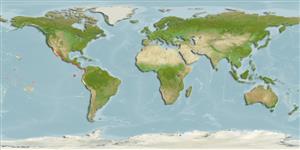Environment: milieu / climate zone / depth range / distribution range
पारिस्थितिकी
समुद्री ड़िमरसल; गहराई सीमा 15 - 150 m (Ref. 9342), usually 60 - 90 m (Ref. 9342). Tropical; 32°N -
Eastern Pacific: Gulf of California to Peru; including the Galapagos Islands.
आकार / वज़न / Age
Maturity: Lm ? range ? - ? cm
Max length : 20.0 cm TL पुल्लिंग / अलिंग; (Ref. 9342); common length : 15.0 cm TL पुल्लिंग / अलिंग; (Ref. 55763)
Body elongate, not very deep, and little compressed, its depth contained 3.2 to 3.8 times in standard length; caudal peduncle very thick; preopercular angle with a broad "spur" consisting of 6 to 12 large spines; first gill arch with 21 to 27 gill rakers; anal rays 8; body grayish brown; flanks with indistinct dark, double, vertical bars; snout and cheeks with yellow stripes; soft dorsal fin with a dark band along its base (Ref. 55763).
Inhabits sand or muddy-sand bottoms. Probably too small in size to be of commercial importance.
Life cycle and mating behavior
परिपक्व अवधि | पुनरुत्पत्ति | मछलीऔ का अंडे देना | अंडे | Fecundity | लार्वा
Heemstra, P.C., 1995. Serranidae. Meros, serranos, guasetas, enjambres, baquetas, indios, loros, gallinas, cabrillas, garropas. p. 1565-1613. In W. Fischer, F. Krupp, W. Schneider, C. Sommer, K.E. Carpenter and V. Niem (eds.) Guia FAO para Identification de Especies para lo Fines de la Pesca. Pacifico Centro-Oriental. 3 Vols. FAO, Rome. (Ref. 9342)
IUCN Red List Status (Ref. 130435)
Threat to humans
Harmless
Human uses
मात्स्यिकी: कोई रुचि बग़ैर
अधिक जानकारी
आम नामउपशब्दचपायचयपरभक्षीईकोटोकसीकोलौजीपुनरुत्पत्तिपरिपक्व अवधिमछलीऔ का अंडे देनाSpawning aggregationFecundityअंडेEgg development
संदर्भजलीयकृषिजलीयकृषि रूपरेखाखींचआनुवंशिकीElectrophoresesहैरेटिबिलटीबीमारीप्रक्रमणNutrientsMass conversion
सहयोगीयोतस्वीरेStamps, Coins Misc.ध्वनिसिगुयटिरारफ्तारतैरने के प्रकारगिल क्षेत्रOtolithsदिमागदृष्टि
साधन
Special reports
Download XML
इंटरनेट स्रोत
Estimates based on models
Preferred temperature (Ref.
123201): 15.3 - 22.8, mean 17.1 °C (based on 22 cells).
Phylogenetic diversity index (Ref.
82804): PD
50 = 0.5002 [Uniqueness, from 0.5 = low to 2.0 = high].
Bayesian length-weight: a=0.00955 (0.00587 - 0.01555), b=3.07 (2.93 - 3.21), in cm total length, based on LWR estimates for this species & Genus-body shape (Ref.
93245).
Trophic level (Ref.
69278): 3.6 ±0.6 se; based on size and trophs of closest relatives
लौटाव (Ref.
120179): माध्यम, न्यूनतम जनसंख्या दुगनी होने का समय 1.4 - 4.4 वर्ष। (Preliminary K or Fecundity.).
Fishing Vulnerability (Ref.
59153): Low vulnerability (10 of 100).
